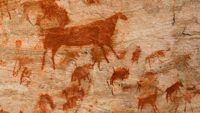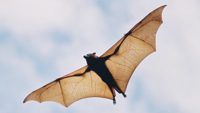In their quest to try and find some sort of evolutionary similarity between humans and apes, scientists have compared DNA, proteins, anatomy, behavior, and every other conceivable feature. But many of these attempts showed that a huge chasm of dissimilarity exists with no distinct evolutionary connection. And now, a new study comparing saliva between humans and apes is once again showing the uniqueness of humans and the failure of evolution… More… …read more Source: icr.org
By John UpChurch Perhaps, in fact, it’s our discomfort with not knowing what to do with cavemen that makes us laugh. So just who were they? …read more Source: AIG Daily
By Harry F. Sanders, III Plants communicate in many ways. This article discusses some of the documented “under-the-table” communications. …read more Source: AIG Daily
By Ken Ham Scientists studying fossil deposits in Morocco recently announced a stunning new find—a series of trilobites (sea creatures, also called ancient cockroaches, now believed to be extinct), fossilized in a single-file line. It looks as if the trilobites were playing, “follow the leader.” That’s the observational evidence. But how to understand these fossils is a matter of interpretation. After all, the fossils don’t come with a tag on them telling you what happened and when. And your interpretation depends on your starting point. The scientists studying these fossils approached the evidence from a naturalistic and evolutionary perspective. Since [More]
Ancient wine vessel depicts sauropod dinosaur …read more Source: creation.com
How could dinosaur proteins persist over 70 million years inside dinosaur bones? That’s one of the biggest questions that secular paleontologists have faced in the last two decades. Many of them reason that some unique but undiscovered set of conditions grant proteins power to defy all odds and somehow survive unimaginable time scales. They think someone, someday, will discover the protein’s secret to survival. A new model sugge… More… …read more Source: icr.org
Do all scientists believe in an old earth? The fatal flaws of radioactive and tree-ring dating and the flat earth myth. …read more Source: creation.com
Creationists should now avoid using this argument. …read more Source: creation.com
How did Phobos and Deimos come to be so close to the red planet? …read more Source: creation.com
Scant bone fragments from a cave on Luzon island suggest yet another fossil human, not an evolutionary intermediate. …read more Source: creation.com
By Ken Ham Which evolved first—moth ears or bat echolocation? Well, the “textbook” evolutionary story is that bats evolved the ability to make ultrasonic calls, which they used to hunt for moths. And then moths supposedly evolved (several times, apparently) the ability to hear these calls and better evade the hunting mammals. Now, that story has been taught as fact for years. But apparently, a new study says this whole story is backwards! Based on this new study (it assumed evolutionary ideas and relationships in the first place), which was described as a “bit of a bombshell,” evolutionary scientists claim [More]
Genetic engineering is no longer in the realm of science fiction. We review a Netflix series called Unnatural Selection and discuss the implications of the CRISPR-Cas9 technology. …read more Source: creation.com
By Dr. Jason Lisle Physics dealing with how the universe operates at very small scales—interactions involving particles smaller than atoms—is called quantum mechanics. …read more Source: AIG Daily
For more than a century, biologists have appealed to Darwinian natural selection to explain how living organisms adapt to different environments. But research over the last several decades has consistently dethroned Darwin’s view of natural selection. Rather than corroborating the concept that environments mold creatures through “survival of the fittest,” the research supports the astonishing idea that to a great extent creature… More… …read more Source: icr.org
By Dr. Danny R. Faulkner Dr. Danny Faulkner evaluates 23 arguments for recent origin for the sun, stars, and galaxies. …read more Source: AIG Daily
By Ken Ham If you’ve ever smelled a meteorite, it probably didn’t have much of an aroma. But that’s not the case with the newest addition to the Field Museum of Natural History in Chicago. This four-pound visitor from outer space (a rare stony meteorite that is called a carbonaceous chondrite) crashed down in Costa Rica’s Alajuela province back in April. And when scientists received the sample, it smelled distinctly like Brussels sprouts! Why—and what does that have to do with creation and evolution? Well, to answer that question, I’ll share some of the text from the article, answering the [More]
By Dr. Danny R. Faulkner Two recent studies of astronomical interest have been in the news. Both are about planets: one near (Saturn) and one far (K2-18b). …read more Source: AIG Daily
A team has come up with an interesting universal addressing system. But did you know living things have a solution to their own ‘address problem’? …read more Source: creation.com
The ability to distinguish the style of a Picasso from a Monet puts a whole new perspective on ‘bird-brainy’ …read more Source: creation.com
New research goes a long way in explaining how creatures actively sense their environment and adapt to it. One mechanism enables some organisms to track the changing levels of nutrients, hormones, or stress they are exposed to, and then make appropriate responses if and when needed. Andrew Capaldi’s lab at the University of Arizona is responsible for these remarkable findings published in Nature Communications.1 Hi… More… …read more Source: icr.org
Is the physical data enough to justify any cosmological theory? …read more Source: creation.com
By Dr. John H. Whitmore The cross-bedded Coconino Sandstone (lower Permian, Arizona) is often used as a “type” ancient eolian sandstone. …read more Source: AIG Daily
By Dr. Tommy Mitchell The story of the peppered moth has been set forth for decades as the prime example of evolution in action. But, are they really evidence of evolution? …read more Source: AIG Daily
Many people of European descent have less melanin in their eyes, and it’s got nothing to do with evolution …read more Source: creation.com
Evolutionary scientists are continually searching for evidence of the “first life” on Earth. Their most recent claim involves well-preserved stromatolite fossils from Australia. Stromatolites are finely laminated biomats formed by colonial cyanobacteria—a complex type of photosynthetic bacteria. Fossil stromatolites are found in mounded structures similar to modern stromatolites. The fossils aren’t composed of the ba… More… …read more Source: icr.org
By Harry F. Sanders, III Because of their isolated natural habitats, guppy populations have been used to study the processes of “evolution” in the wild. …read more Source: AIG Daily
New findings continue to support ICR’s theoretical assumption that biological functions are best explained by engineering principles.1 These findings challenge long-held Darwinian assumptions that the environment is responsible for “selecting” creatures, causing them to adapt. Rather, creatures appear designed from the start to sense their environment and adapt accordingly. The latest research comes from the lab… More… …read more Source: icr.org

















![Morning’s Coming [Live] Morning’s Coming [Live]](http://img.youtube.com/vi/-163MgosiJE/0.jpg)

























